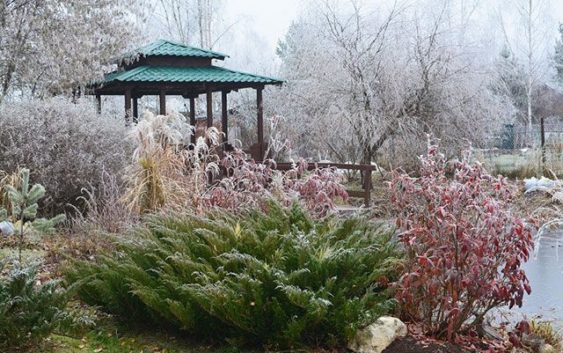Not all summer residents close the season early. Some people keep coming to the site, until the snow falls, and in winter too.
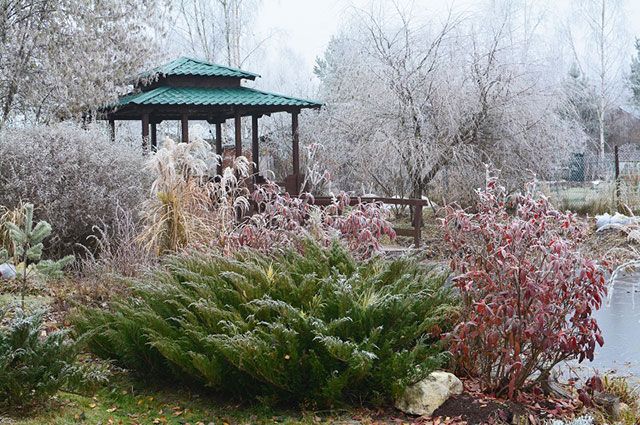
So «polar explorers» fundamentally, to make the garden look attractive even in November, when the colorful foliage has already flown around and there are almost no colors left.
«Waves»
Ornamental grasses that are gaining more and more popularity can not only decorate the garden, and transform it into a fairy tale. В ноябре, when most of the herbaceous perennials have already been cut, the highest and medium-sized cereals come to the fore and brilliantly perform the led part. They are especially good in hoarfrost or with the first snowball.. the main thing, do not be wrong with that, which of them will cope with such a responsible role. After all, some herbs have rather fragile flowering stems, which break under the very first gusts of autumn wind and under the weight of wet snow. These include, for example, varieties of lightning reed, millet rod-shaped, turf pike.
In order to admire cereals not only in gloomy November, but also later, until spring, it is best to plant powerful varieties of miscanthus Chinese that are resistant in the climate of the middle zone of Russia, eg, ‘Huron Sunrise’, ‘Malepartus’, ‘Nippon’, ‘Nishidake’, "Silver pen", or m blushing in autumn. ‘Purpurascens’. The sharp-flowered reed will also be a good choice., especially the ‘Karl Foerster’ variety. Its strong, upright stems can withstand even very strong winds.. I saved the garden pond, which was covered with the first ice, with success;. Besides, in late autumn and winter, the massifs of miscanthus sugarflower and southern reed are very good, but both of these cereals, chagrin, very aggressive, which imposes restrictions on their implementation in gardens.
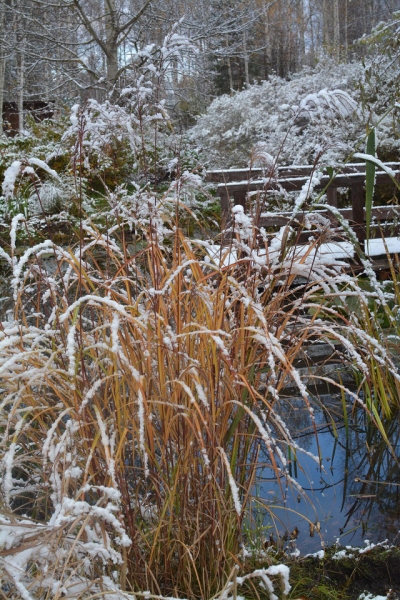
Miscanthus. A photo: From personal archive / Maria Yurasova
«Carpets»
There are plants among herbaceous perennials, whose leaves remain greenish even in winter. Of course, they will simply not be visible under the snowdrifts, but on the other hand, in November, they make a significant contribution to the decoration of the garden. The first violin is played by the evergreen handsome badan, which will be found, пожалуй, in any garden. The hellebores have the opportunity to accompany him, liverworms, some geraniums and, naturally, Heychera and Heycherell. Unlike all past plants, the varieties of the last two species delight in an impressive variety of colors.. Thanks to them, the November garden can burst into amber, purple, reddish, purple— just like in the midst of a golden light. Unless this colorful extravaganza will unfold not on the branches of trees and bushes, and against the background of the ground tackled by frosts.
Another fascinating plant, not yet appreciated by our summer residents, — this is a mountain woman. Some of its many species and species are remarkable not only for flowering, but also with wintering foliage. Low bushes, expanding, form beautiful carpets, which are very good under the crowns of trees (mountain women do not like open spaces). And in November, their greenery is especially pleasing to the eye..
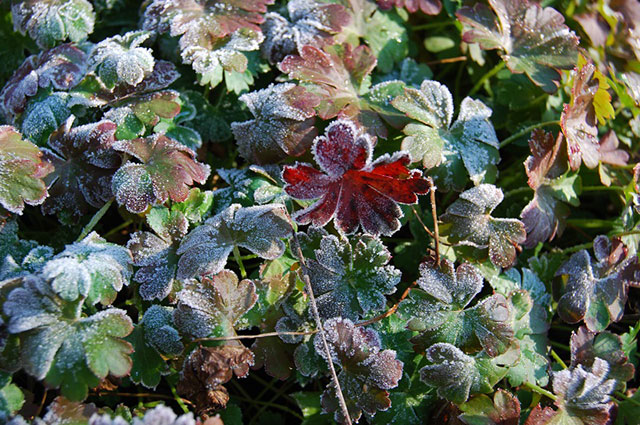
Geranium. A photo: From personal archive / Maria Yurasova
Greenish leaves
Trees and bushes with evergreen foliage bring a summer touch to the gamut of the November garden: dwarf euonymus, narrow-leaved squid, mahogany, rhododendrons. Underlined «southern» the sight of these plants helps to forget for a while, that there are blizzards and frosts on the nose. Truth, with the arrival of winter, most of them are better covered, but in late autumn they still do not need protection from the cold and dryness and very liven up the picture.
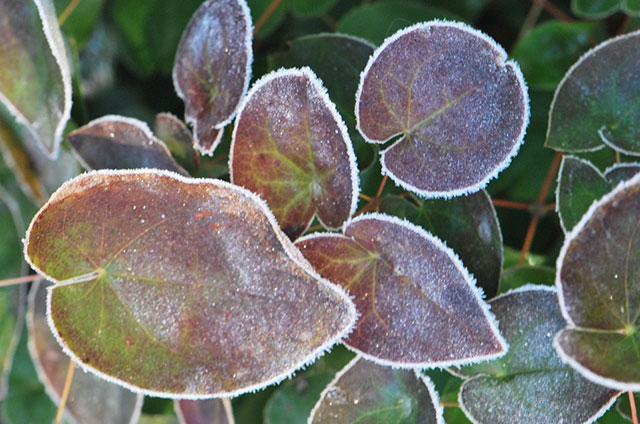
Goryanka. A photo: From personal archive / Maria Yurasova
Unusual shapes
When foliage flies from trees and bushes, silhouette comes to the fore. The beautiful shape of the crown or the unusual bending of the branches in a leafless state attract much more attention., чем летом.
From this point of view, the sinuous forms of woody and shrub plants are of extraordinary value., for example, лещины ‘Twisted’ и ‘Red Majestic’, dark alder 'Greenwood', ‘Spider Alley’ birch, Sverdlovsk willows, larch 'Diana’ и ‘Horstmann Recurved’ (after all, they also drop needles in the dawn). The mountain ash ‘Pendula’ hanging down to the ground «twisted» branches.
Plants with the so-called tapered shoots are no less interesting.. Their highlight— flat branches grown together with each other (this phenomenon is called fasciation), which are especially noticeable in the absence of foliage. Regardless of the botanical species, they are most often called 'Monstrosa'. Among them there is a chestnut, alder, elderberry, etc..
A frosty tree or bush of an unusual shape looks especially picturesque, but even without additional accessories it simply becomes an impressive accent in an empty autumn garden. A single copy is enough— and November in the country will never be sour.
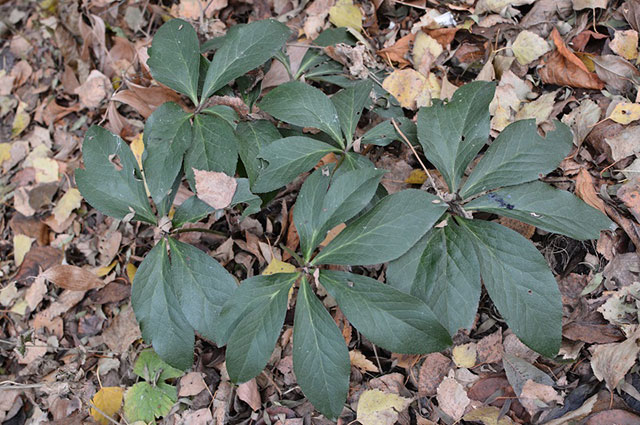
Hellebore. A photo: From personal archive / Maria Yurasova
There is a thought!
Fans of Japanese gardens should take on a variety of mosses. Of course, growing them in the garden is not so easy, how it might seem to a person with little knowledge, but, if the idea is successful, the garden will take on a very special look. Contemplating moss pillows, scattered under trees among stones or decorating the shore of a pond, help to find inner peace and harmony. And what else is needed in a dank autumn? Plus, mosses don't require cumbersome maintenance.— главное, provide them with moisture.
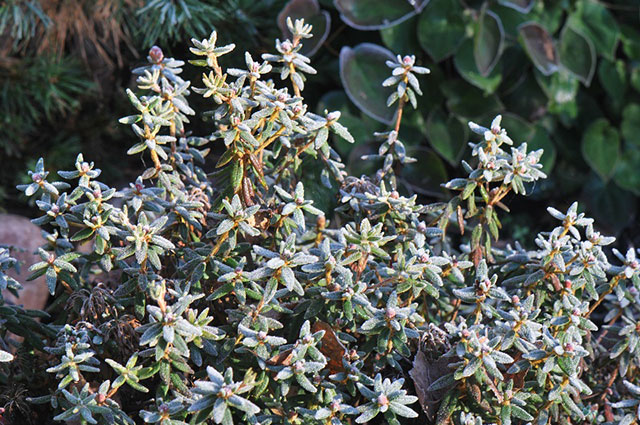
Bagulnik. A photo: From personal archive / Maria Yurasova
A source: aif.ru

